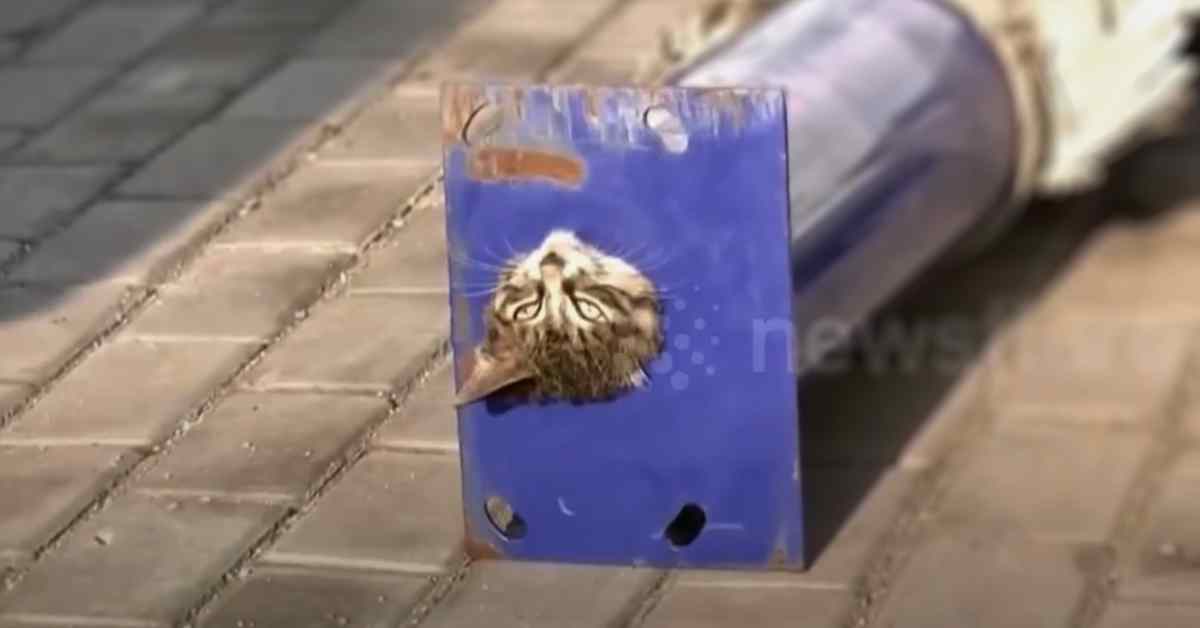We all know that cats have 9 lives and that some cats like to make use of as many lives as they can. Our cats love to explore every inch of our house and find the best possible hiding places and things to climb on.

Story and photos source credited to animal antics YouTube.
Lychee our kitten often finds new places to crawl under and it sometimes takes a while to work out where he is. In the photo above you can see a stray cat in China that managed to get stuck in a blue pipe. It looks like he went too far, reached a narrow section of the pipe and just couldn’t reverse out.

Luckily people spotted the poor cats head popping out of the pipe and called firefighters to come help. This wasn’t an easy rescue, they had to cut a section of pipe using a saw and then after some effort the cat finally came out. The pipe was destroyed but everybody was relieved that the cat was safe.

The cat didn’t waste any time saying thank you though, clearly shocked by his little adventure, he ran off, no doubt to find somewhere better to hide away where he hopefully won’t get stuck next time.

Watch the cat freed in the video below and then read on to learn more about why cats like to fit into small spaces. You might also like to read about what an incredible dog lover does every year for her disabled dog.
Cats and small spaces.
Cats have an incredible ability to squeeze into tight spaces, often leaving their owners baffled and amused. This unique talent stems from several fascinating aspects of feline anatomy and behavior, which together create the perfect conditions for their escapades into nooks and crannies.
Firstly, cats possess highly flexible skeletons. Unlike humans, cats have free-floating clavicle bones, which are not attached to other bones but instead are connected to muscles. This gives them a significant range of motion and allows their shoulders to collapse inward, enabling them to pass through openings as small as their heads.
Their flexible spines also play a crucial role; the vertebrae are loosely connected, which means cats can twist and contort their bodies to fit through tight spaces.
In addition to their skeletal flexibility, cats have a unique way of moving. Their gait is known as a “direct register,” meaning their back paws step into the same spots as their front paws.
This precise and deliberate way of walking minimizes noise and helps them navigate through narrow paths and gaps without making a sound. Their retractable claws add to their stealth and precision, providing grip when needed and reducing the likelihood of getting stuck.
Behaviorally, cats are naturally curious creatures. Their instinct to explore and investigate their surroundings drives them to seek out and enter small spaces. This behavior is rooted in their evolutionary history as predators and prey.
Small, enclosed spaces offer safety and a strategic vantage point from which to observe their environment or ambush prey. They also provide a sense of security and warmth, which is why cats often seek out boxes, bags, and other confined areas to rest.
Another intriguing aspect is a cat’s whiskers, which are highly sensitive tactile hairs that can detect changes in their surroundings. Cats use their whiskers to gauge the width of openings and spaces.
If a cat’s whiskers can fit through a gap without bending too much, the cat knows it can likely fit its body through as well. This remarkable sensory ability helps them navigate tight spaces with confidence.
Interestingly, as in the story above, this penchant for squeezing into tight spots can sometimes lead to trouble. Cats can become trapped if they misjudge the space or if their exploratory nature takes them into dangerous areas.
As such, it’s important for cat owners to ensure that potential hazards are minimized and that their pets have plenty of safe, comfortable spots to satisfy their curiosity.
Final thoughts.
The ability of cats to fit into tight spaces is a marvel of nature, combining anatomical flexibility, behavioral instincts, and sensory precision. This talent not only highlights the adaptability of cats but also their enduring curiosity and desire for security.
Understanding these traits can help cat owners create a more enriching and safe environment for their feline friends.

